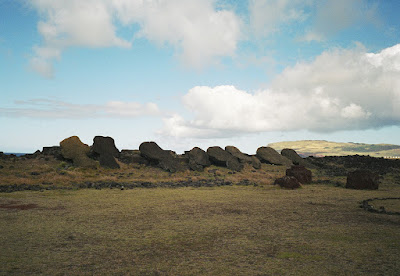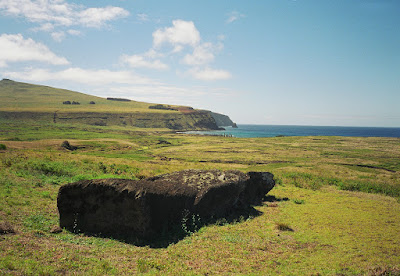1 Sep 2002
There was an American woman, Sarah, staying in my hospedaje (hostel). I'm not sure if she took pity on my green-ness or just liked company, but we spent the next few days touring the island together, via foot and a little Suzuki 4WD.
On the first day we walked (a long) eight hours along the remote west coast from the town of Hanga Roa to the only surf beach on the island, Anakena. The terrain was spectacular, and typical of Easter Island: a blanket of verdant grass liberally scattered with black basalt boulders - not a tree to be seen except where planted by human. Along the way was a charming homestead nestled between escarpment and ocean, where we met a mainland Chileno who spent his summers there - quite the beach shack! He explained that the polypipes we had encountered were actually for pumping fresh water out of the sea. There is little in the way of surface water, so underwater springs are critical.
 |
| On the way to Anakena |
Anakena is where the first Polynesians would have arrived, and where Thor Heyerdahl completed his voyage on the Kontiki in an attempt to prove that the Easter Islanders came from South America (he was wrong). Easter Island is, of course, famous for its massive sculptures (moai) which stand on platforms (ahu) overlooking old village sites. They are said to be ancestors looking over and protecting their descendents. But when the first Europeans arrived, they had all been toppled.
 |
| Ahu Hanga Poukura |
At Anakena there is a solitary standing moai, which Heyerdahl raised manually, to prove it could be done without modern technology. But to move and erect a statue uses huge amounts of timber. In Jared Diamond's book Collapse, he argues that the islanders got carried away in a frenzy of one-up-moai-ship, going so far as to cut down all the trees, which triggered an ecological collapse, soon followed by social collapse, and the moai were toppled in the resulting inter-tribal warfare. By the time Europeans arrived, only a few desperate islanders remained to scrape a poor living from the degraded landscape - easy pickings for slavers. Another hypothesis puts the blame on introduced rats, which ate the seeds and seedlings of the native trees so they couldn't regenerate. And yet another that there was no social collapse, and that it was all the European's fault.
Whatever the case, the moai are truly incredible, and the vistas are uninterrupted. At the main quarry of Rano Ruraku there is the largest moai ever made, but which never made it to an ahu. It is 20m long! The largest erected was 10m.
 |
| The quarry at Rano Raraku |
 |
| Buried moai at Rano Raraku |
My visit to Easter Island was a great success, though the prospect of not having Sarah and her Spanish was slightly worrying ... I'll finish with this pithy observation from my diary:
"At Ahu Tongariki we saw a photographer and a girl scantily dressed. They were taking photos for postcards. Funny."
 |
| View towards Ahu Tongariki |
 |
| Ahu Tongariki |
 |
| View from Maungu Puakatiki |
 |
| Sunset and storm from Maunga Terevaka, the highest point on the island at 506m |


No comments:
Post a Comment